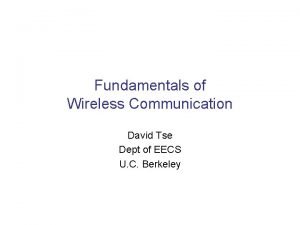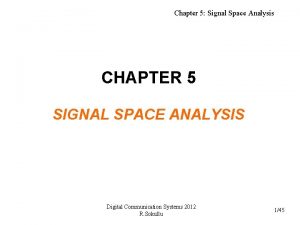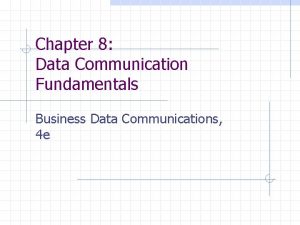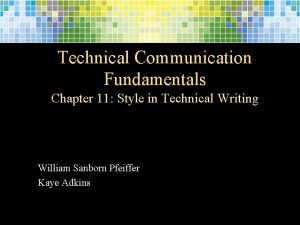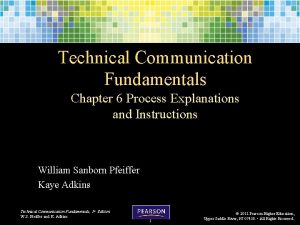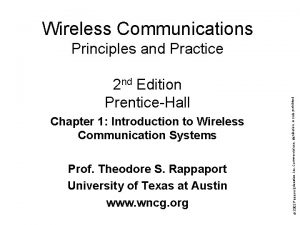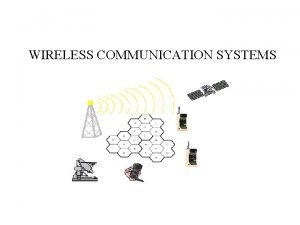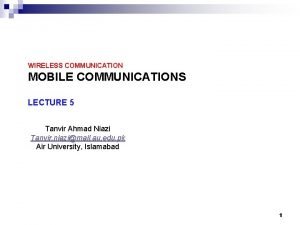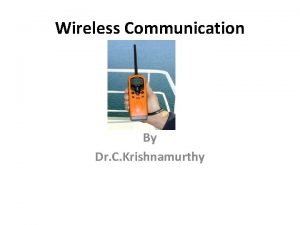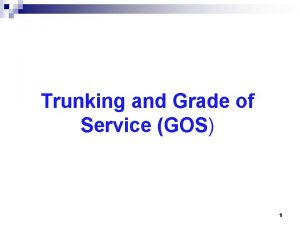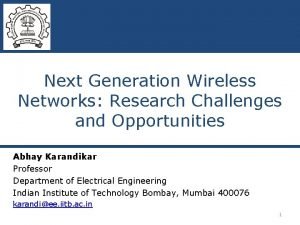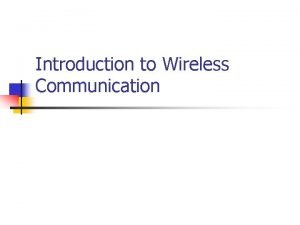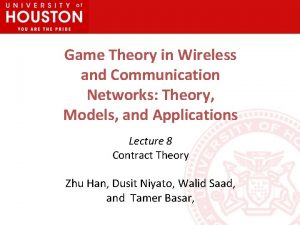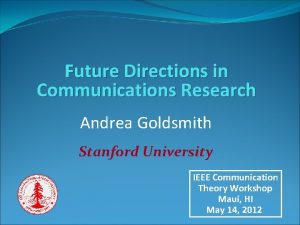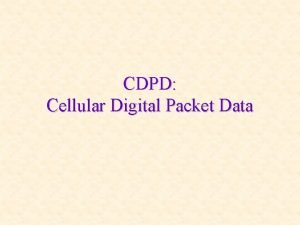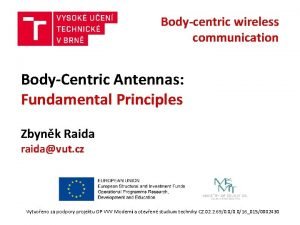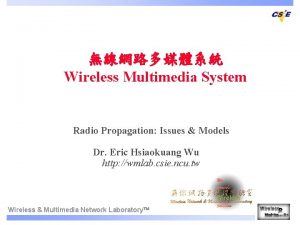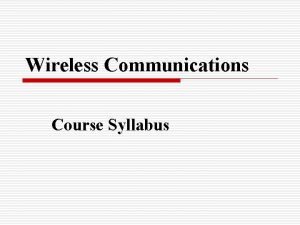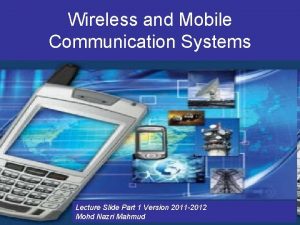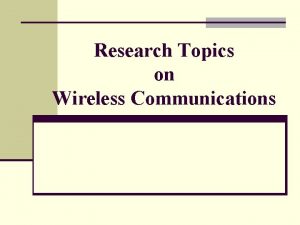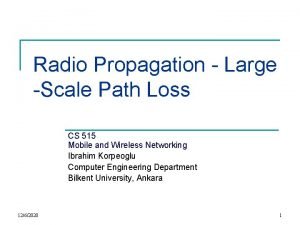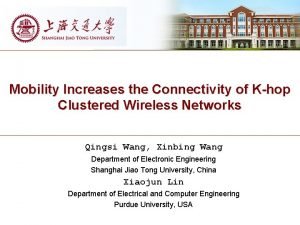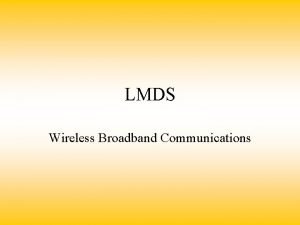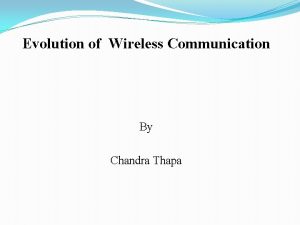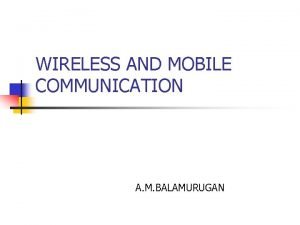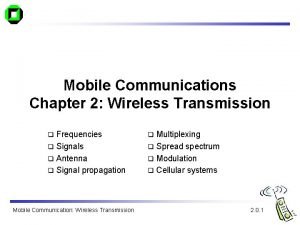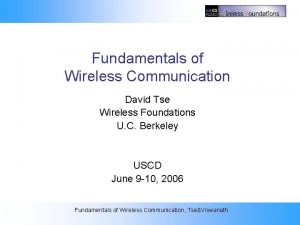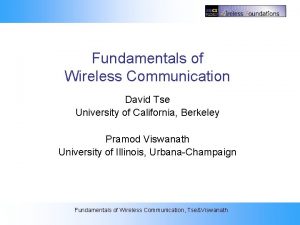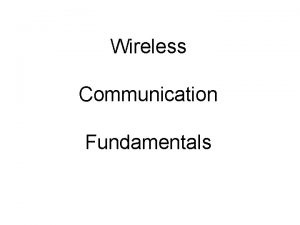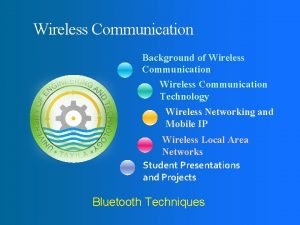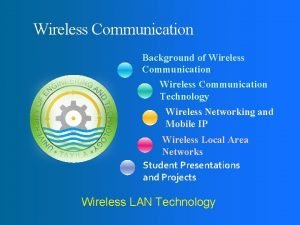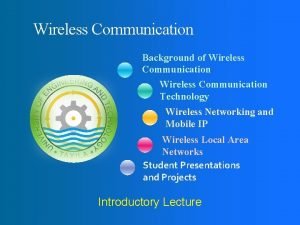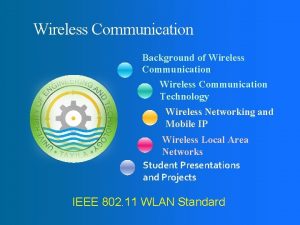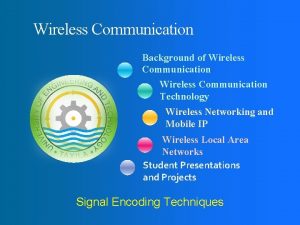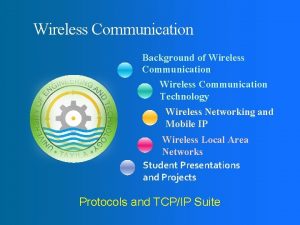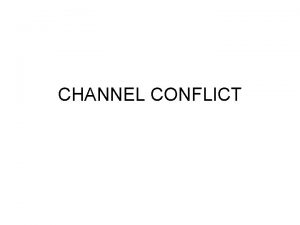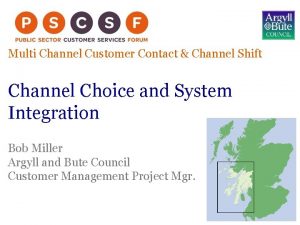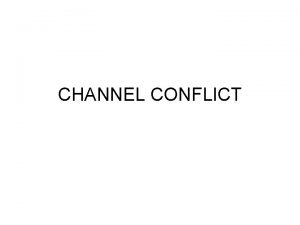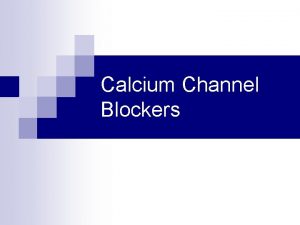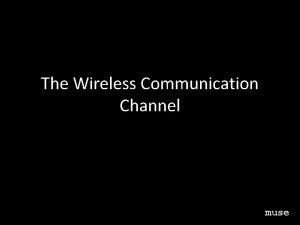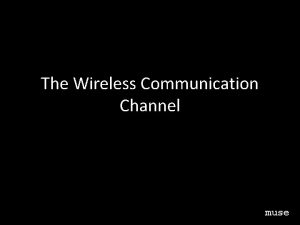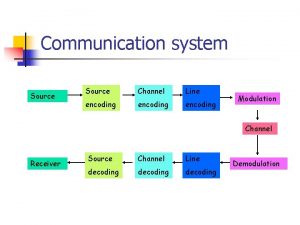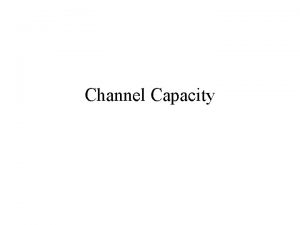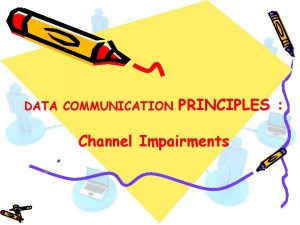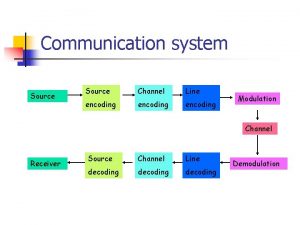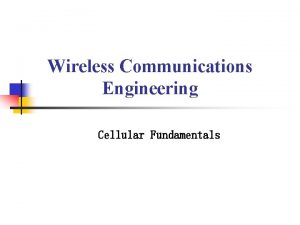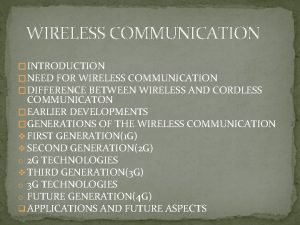2 The Wireless Channel Fundamentals of Wireless Communication































- Slides: 31

2: The Wireless Channel Fundamentals of Wireless Communication David Tse University of California, Berkeley Pramod Viswanath University of Illinois, Urbana-Champaign Fundamentals of Wireless Communication, Tse&Viswanath

2: The Wireless Channel 1. Introduction Fundamentals of Wireless Communication, Tse&Viswanath

2: The Wireless Channel Course Objective • Past decade has seen a surge of research activities in the field of wireless communication. • Emerging from this research thrust are new points of view on how to communicate effectively over wireless channels. • The goal of this course is to study in a unified way the fundamentals as well as the new research developments. • The concepts are illustrated using examples from several modern wireless systems (GSM, IS-95, CDMA 2000 1 x EV-DO, Flarion's Flash OFDM, Array. Comm systems. ) Fundamentals of Wireless Communication, Tse&Viswanath 2

2: The Wireless Channel System Implementation Capacity limits and communication techniques Channel modelling Fundamentals of Wireless Communication, Tse&Viswanath 3

2: The Wireless Channel Course Outline Part I: Basics 2. The Wireless Channel 3. Diversity 4. Multiple Access and Interference Management 5. Capacity of Wireless Channels Fundamentals of Wireless Communication, Tse&Viswanath 4

2: The Wireless Channel Course Outline (2) Part II: Modern Wireless Communication 6. Opportunistic Communication and Multiuser Diversity 7. MIMO I: Spatial Multiplexing and Channel Modeling 8. MIMO II: Capacity and Multiplexing Architectures 9. MIMO III: Diversity-Multiplexing Tradeoff Fundamentals of Wireless Communication, Tse&Viswanath 5

2: The Wireless Channel Assumed background: • Basic signals and systems, linear algebra and probability. • Basic digital communications. Fundamentals of Wireless Communication, Tse&Viswanath 6

2: The Wireless Channel These slides only gives an overview of the ideas. Full details can be found in: http: //www. eecs. berkeley. edu/~dtse/book. html Fundamentals of Wireless Communication, Tse&Viswanath 7

2: The Wireless Channel 2. The Wireless Channel Fundamentals of Wireless Communication, Tse&Viswanath

2: The Wireless Channel Wireless Mulipath Channel varies at two spatial scales: large scale fading small scale fading Fundamentals of Wireless Communication, Tse&Viswanath 9

2: The Wireless Channel Large-scale fading • In free space, received power attenuates like 1/r 2. • With reflections and obstructions, can attenuate even more rapidly with distance. Detailed modelling complicated. • Time constants associated with variations are very long as the mobile moves, many seconds or minutes. • More important for cell site planning, less for communication system design. Fundamentals of Wireless Communication, Tse&Viswanath 10

2: The Wireless Channel Small-scale multipath fading • Wireless communication typically happens at very high carrier frequency. (eg. fc = 900 MHz or 1. 9 GHz for cellular) • Multipath fading due to constructive and destructive interference of the transmitted waves. • Channel varies when mobile moves a distance of the order of the carrier wavelength. This is about 0. 3 m for 900 Mhz cellular. • For vehicular speeds, this translates to channel variation of the order of 100 Hz. • Primary driver behind wireless communication system design. Fundamentals of Wireless Communication, Tse&Viswanath 11

2: The Wireless Channel Game plan • We wish to understand how physical parameters such as – – – carrier frequency mobile speed bandwidth delay spread angular spread impact how a wireless channel behaves from the communication system point of view. • We start with deterministic physical model and progress towards statistical models, which are more useful for design and performance evaluation. Fundamentals of Wireless Communication, Tse&Viswanath 12

2: The Wireless Channel Physical Models • Wireless channels can be modeled as linear time-varying systems: where ai(t) and i(t) are the gain and delay of path i. • The time-varying impulse response is: • Consider first the special case when the channel is timeinvariant: Fundamentals of Wireless Communication, Tse&Viswanath 13

2: The Wireless Channel Passband to Baseband Conversion • Communication takes place at • Processing takes place at baseband Fundamentals of Wireless Communication, Tse&Viswanath 14

2: The Wireless Channel Complex Baseband Equivalent Channel • The frequency response of the system is shifted from the passband to the baseband. • Each path is associated with a delay and a complex gain. Fundamentals of Wireless Communication, Tse&Viswanath 15

2: The Wireless Channel Modulation and Sampling Fundamentals of Wireless Communication, Tse&Viswanath 16

2: The Wireless Channel Multipath Resolution Sampled baseband-equivalent channel model: where hl is the l th complex channel tap. and the sum is over all paths that fall in the delay bin System resolves the multipaths up to delays of 1/W. Fundamentals of Wireless Communication, Tse&Viswanath 17

2: The Wireless Channel Sampling Interpretation • hl is the l th sample of the low-pass version of the channel response hb(¢). • Contribution of the i th path is the projection of aib ( - i) onto sinc(W -l). Fundamentals of Wireless Communication, Tse&Viswanath 18

2: The Wireless Channel Flat and Frequency-Selective Fading • Fading occurs when there is destructive interference of the multipaths that contribute to a tap. Delay spread Coherence bandwidth single tap, flat fading multiple taps, frequency selective Fundamentals of Wireless Communication, Tse&Viswanath 19

2: The Wireless Channel Effective channel depends on both physical environment and bandwidth! Fundamentals of Wireless Communication, Tse&Viswanath 20

2: The Wireless Channel Time Variations Doppler shift of the i th path Doppler spread Coherence time Fundamentals of Wireless Communication, Tse&Viswanath 21

2: The Wireless Channel Two-path Example v= 60 km/hr, fc = 900 MHz: direct path has Doppler shift of -50 Hz reflected path has shift of +50 Hz Doppler spread = 100 Hz Fundamentals of Wireless Communication, Tse&Viswanath 22

2: The Wireless Channel Doppler Spread Doppler spread is proportional to: • the carrier frequency fc; • the angular spread of arriving paths. where i is the angle the direction of motion makes with the i th path. Fundamentals of Wireless Communication, Tse&Viswanath 23

2: The Wireless Channel Fundamentals of Wireless Communication, Tse&Viswanath 24

2: The Wireless Channel Types of Channels Fundamentals of Wireless Communication, Tse&Viswanath 25

2: The Wireless Channel Typical Channels are Underspread • Coherence time Tc depends on carrier frequency and vehicular speed, of the order of milliseconds or more. • Delay spread Td depends on distance to scatterers, of the order of nanoseconds (indoor) to microseconds (outdoor). • Channel can be considered as time-invariant over a long time scale. Fundamentals of Wireless Communication, Tse&Viswanath 26

2: The Wireless Channel Statistical Models • Design and performance analysis based on statistical ensemble of channels rather than specific physical channel. • Rayleigh flat fading model: many small scattered paths Complex circular symmetric Gaussian. Squared magnitude is exponentially distributed. • Rician model: 1 line-of-sight plus scattered paths Fundamentals of Wireless Communication, Tse&Viswanath 27

2: The Wireless Channel Correlation over Time • Specified by autocorrelation function and power spectral density of fading process. • Example: Clarke’s (or Jake’s) model. Fundamentals of Wireless Communication, Tse&Viswanath 28

2: The Wireless Channel Additive Gaussian Noise • Complete baseband-equivalent channel model: • Special case: flat fading: • Will use this throughout the course. Fundamentals of Wireless Communication, Tse&Viswanath 29

2: The Wireless Channel Summary • We have understood how time and frequency selectivity of wireless channels depend on key physical parameters. • We have come up with statistical channel models that are useful for analysis and design. Fundamentals of Wireless Communication, Tse&Viswanath 30
 David tse fundamentals of wireless communication
David tse fundamentals of wireless communication Telecommunications the internet and wireless technology
Telecommunications the internet and wireless technology Types of multi channel retailing
Types of multi channel retailing Conversion of continuous awgn channel to vector channel
Conversion of continuous awgn channel to vector channel Jfet self bias configuration
Jfet self bias configuration Fundamentals of data communication
Fundamentals of data communication Style in technical communication
Style in technical communication Fundamentals of organizational communication
Fundamentals of organizational communication Fundamentals of organizational communication 9th edition
Fundamentals of organizational communication 9th edition Technical communication fundamentals
Technical communication fundamentals Wireless communication introduction
Wireless communication introduction System 1 evolution
System 1 evolution Cell dragging in wireless communication
Cell dragging in wireless communication Advantages of wireless communication
Advantages of wireless communication What is grade of service
What is grade of service Next generation wireless communication market
Next generation wireless communication market Advantages of wireless communication
Advantages of wireless communication Game theory in wireless and communication networks
Game theory in wireless and communication networks Andrea goldsmith stanford
Andrea goldsmith stanford Cdpd in wireless communication
Cdpd in wireless communication Fundamental principles of wireless communication
Fundamental principles of wireless communication Free space propagation model in wireless communication
Free space propagation model in wireless communication Wireless communication course syllabus
Wireless communication course syllabus Large scale fading in wireless communication
Large scale fading in wireless communication Wireless communication research topics
Wireless communication research topics Free space propagation model in wireless communication
Free space propagation model in wireless communication Free space propagation model in wireless communication
Free space propagation model in wireless communication Microcontroller wireless communication
Microcontroller wireless communication Lmds architecture
Lmds architecture Evolution of wireless communication
Evolution of wireless communication Mobile communication syllabus
Mobile communication syllabus Wireless communication
Wireless communication
